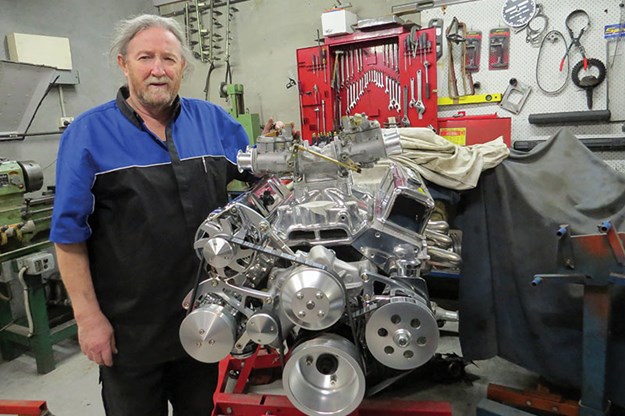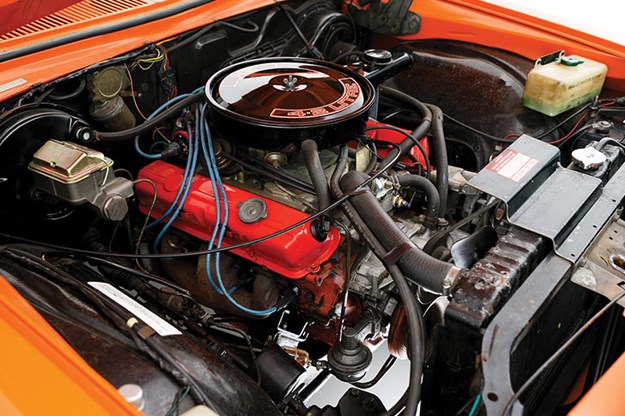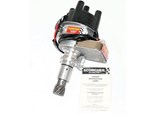Check the numbers, Pine-O-Cleen, 253 V8 and Dattos - Mick's Workshop 452



|
Check those numbers before buying, Pine-O-Cleen a miracle cure, Holley tuning, pre-trip fettling and more
We’ve just had a bit of a nasty shock in the workshop. A customer dropped off a really lovely VW Beetle project and asked us to apply some finishing touches to get it running right, then give it a roadworthy. No problem. Or not usually. We like working on Beetles and they’re pretty simple things to sort out.
Then one giant problem raised its ugly head when we went to fill out the roadworthy certificate. The numbers on the car were wrong.
It’s not that anyone had done anything illegal. It’s just over time this thing has been built up using bits from various cars and, when we get to finishing it off, discover there is a whole mess of numbers that don’t match. We have a chassis number that isn’t matching the compliance plate that isn’t matching the build tag.
This is more common than many people realise. You come across it a lot, for example on old Chevs and Holdens, which have numbers stamped on the chassis. One-tonners are a good example: someone decides to replace the rusted-out body with a better one, but the chassis is still good. What they forget to do is keep the correct tags.
This really needs to be sorted out when the work is being done. If you can’t transfer across the tags, you need to contact your local rego people and talk to them, so there’s some sort of record of the change-over.
In the case of the Beetle, we’re going to have to approach Vic Roads (our local rego folk) and have a chat. They’ll need to see the car and it’s possible they’ll hang on to it for while. I have seen previous cases where ‘a while’ is six months!
So the moral to this story is don’t rush in when you’re buying. Okay you see a project sitting in a shed that you like the look of and you’ve negotiated a fair price. Before you go handing out the readies, do your homework and check the numbers are what they should be. If there’s a number on the chassis, does it match what’s on the ADR plate? Is the ADR plate there at all?
Now it might be the car has been rebodied and the plate you need is somewhere in the shed or even in the back paddock – make sure you get it.
I’d also be chasing down any evidence of the car having been registered before. You’re also looking out for evidence that the engine may have been swapped – which is fine, but was the local rego mob notified and is it appropriate to that car?
None of these issues need to be a deal-breaker, if you can gather up the elements you need. But it’s a lot easier to sort it out before you buy, than to discover your car is impounded for months while the local authorities decide its fate.
TOM’S MONARO
Work progresses on Tom’s mighty Monaro, the massive project build we’ve been working on. As you can see in the pic below, we’ve found some ‘jewellery’ for the running gear at the front of the motor. That was harder to find than we expcted.
You might recall the powerplant is a GM small block that we’ve taken out to 427. We found the kit we wanted through a Street Machine mag advertiser, Australian Rod & Custom Components in Queensland. Looks good, doesn’t it?
Weirdly our next challenge has been finding a full set of short spark plugs, so we get plenty of clearance from the close-fit headers. Thanks to Covid, local stocks have disappeared and we’ve had to get them shipped in.
PINE-FRESH

Now you might notice a weird tip for this issue, which suggests using Pine-o-Cleen. Let me tell you the story behind that. Many many years ago, when Holden Camiras were running about, I had a one come in that had a sump full of mayonnaise.
I knew not to immediately assume that it had a blown head gasket – there may be another cause, so do your due diligence. We checked it multiple times and were positive the head gasket was fine.
So I duly flushed out the cooling system and the engine, put it all back together and the next day it had oil back in the cooling system. The customer was okay but not really happy. After spending the next four days and wasting copious amounts of oil and coolant, I was beginning to pull my hair out.
I contacted quite a few people and ended up talking to a mechanic who was getting on a bit by then. He said, "Mick, take the water pump off – the problem will be there." I explained there was nothing wrong with the pump and it was working perfectly. He told me to have a look. So off came the pump and we discovered that behind it Holden had decided to fit an Allen-head plug into the block. Cavitation had eaten away at it and there was the leak. Unbelievable.
So I rang him back to say thanks, we’d fixed it, but we were having so much trouble flushing the remnants of the oil out of the cooling system. He said, "Mick, go buy yourself some Pine-o-Cleen." That was 35 years ago and I’m still using it today. In fact, I keep a few bottles on the shelves.
I don’t know how or why it works. It has to be original ‘brown’ liquid and you throw it in with the coolant, let it run around for a week so the oil emulsifies with the coolant, then change it all over. It doesn’t hurt anything, your heater smells ‘pine-fresh’ for a while and it works a treat.
Okay, is there a chemist out there who can explain that one to us? Drop me a line via uniquecars@primecreative.com.au
Here's my tip:
Pine-O-Cleen

If you’ve recently fixed a head gasket and are having trouble flushing out the last of the oil residue from your coolant circuit, try dropping a bottle of the original (brown) Pine-O-Cleen into the cooling system and running it for about a week before flushing it. See the main text for the story on how we came across this little gem!
LETTERS:
In a Jiffy
I always enjoy reading your column, I took your advice from the last issue about using Jiff on plastic headlights. I tried it on one of my HSVs and the lights are improved dramatically - not perfect but for $3.00 for a bottle from my local supermarket I couldn’t be happier.
I was so impressed I then tried your trick on the orange indicators of one of my VH SL/Es, they came up mint! What a great little tip you shared with us all, thanks.
Chris
GLAD IT worked for you, Chris. I’m not usually in the business of recommending using household cleaning products on cars, but wait till you see this issue’s tip!
302 Carby
I’m in the process of finishing off a top-end freshen-up of a Ford 302 engine for my XT Falcon and am fitting a 650 Holley as part of the job.
Any advice on how to go about tuning it?
Bill Franks
WE NEED to know what heads you’re using – hopefully it’s the old open-chamber 2V heads, which are much easier to work with. The closed chamber 4V heads need a different approach.
The way to tune a Holley isn’t rocket science – you need a vacuum gauge. If it’s an auto, you need it in gear. Run the engine at idle and measure the vacuum.
You halve the measurement in inches of mercury for the size of your powervalve. If you’re pulling 22 inches in a fairly standard engine, you halve that for the powervalve. If it’s running a reasonable cam, it might be 15 inches, the powervalve is 7.5, and so on.
If you’re using four jets, you’re running four sizes different in the jets front to rear. If it’s a vacuum secondary, you’re only worrying about the front jets.
It’s then a matter of driving it and reading the plugs. Our industry is very tactile, and you can often smell what it needs before you read plugs.
You’ll find when you unpack the carby that, with exception for the powervalve, the Holley settings are usually reasonably close – within a couple of sizes for the jets.
Generally the car will tell you if it’s too rich or lean. If in doubt, it’s not a hugely expensive exercise to drop in to workshop and get some help to fine-tune it. That can provide some peace of mind.
The good thing is that once they’re done, that’s it. They’re set and forget.
Fresh Datsun
I’ve picked up a Datsun 280Z as a project car. Overall it’s pretty tidy but it’s been to the moon and back with 320,000km on it.
That seems like a lot and it feels like it needs a freshen-up. How far would you go with it?
Nick Leeman
SHORT ANSWER – you might as well do it from the crank shells and up. With that sort of mileage, there is nothing in there that won’t have an effect on the other parts, so it makes sense to do it all. It will have valve recession, the cam lobes will be well worn, all these things come into play.
They’re a great motor and will take a huge amount of abuse. They’re a good thing to work on and it’s well worth the effort.
You’d get the crankshaft reground, taking off the bare minimum, get the thing line bored and measure the bores for ovality. They’ve got a reasonably thick wall, so it you went 30 or 40 thou up you’d get a nice straight cylinder which would never wear out.
You may find the rods are still okay, but you’d have them resized and shot-peened. Then again, it’s not overly expensive to get new ones.
Then you’re up for new slugs, cam and cylinder head rebuild. Do it properly and the engine will probably outlast all of us!
Trip Check

Holden’s 253 just needs some basic love for a big trip
I’m finally getting ready for the first big road trip in a couple of years. We’re taking the 253 HQ Holden which seems to be running okay.
What do suggest as prep for the trip?
Diane Keen
A 253 HQ! Love them. If it’s a big adventure, you might want ignition spares – points rotor and cap for the distributor if it’s still running them, or a spare igniter if it’s been converted to a solid-state Bosch unit.
I’d be tempted to change the hoses and belts and chuck the old ones in the boot as spares.
Give it the once-over: the coolant is clean and green, it’s got good engine oil, the trans oil (if it’s an auto) is nice and pink, and the diff oil has been checked.
It’s all stuff that can be done cheaply and you can take off knowing you’re prepared for pretty much anything. They’re a great old thing and will lap the country without stress.
Grinder

My E39 BMW, a 540, is making this strange and loud grinding noise just as the starter motor is disengaging. What’s going on?
James H
ED GUIDO has a similar car and it’s done the same thing – it’s a common enough problem across lots of makes. That needs to be attended to before it does any damage. The Bendix or pinion gear on the starter is sticking and not disengaging properly. It’s not a huge problem and it usually means just whipping out the starter and cleaning it up. If it’s let go, it will eventually chew out the ring gear. Not a big job.
TRIVIAL PURSUIT
False start

The first time the popular US cartoon strip Charlie Brown was animated was for a 1959 Ford commercial. Charlie was handing out chocolate cigars to celebrate the ‘birth’ of a new car.
Want some advice on a build or a potential car purchase? Heck we’ll even tackle long distance diagnosis!
Drop MIck a line at uniquecars@primecreative.com.au
From Unique Cars #452, April 2021
Unique Cars magazine Value Guides
Sell your car for free right here
Get your monthly fix of news, reviews and stories on the greatest cars and minds in the automotive world.
Subscribe

.jpg)












